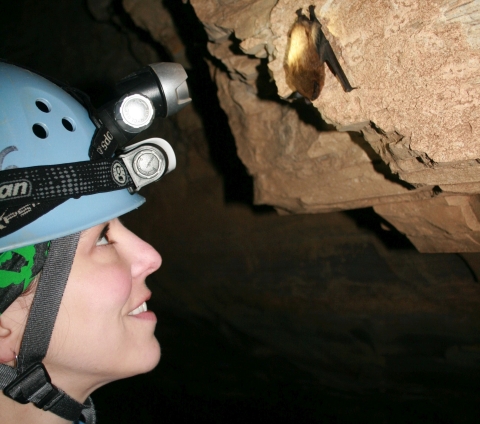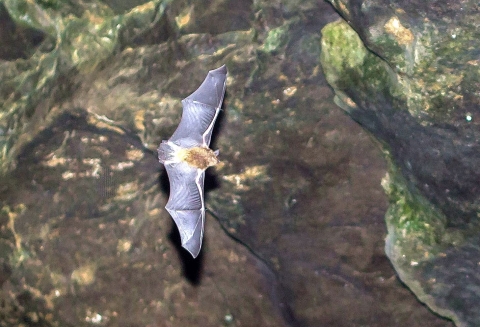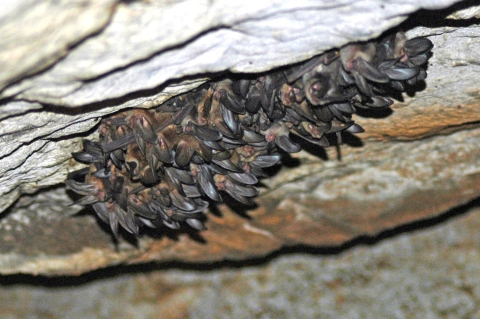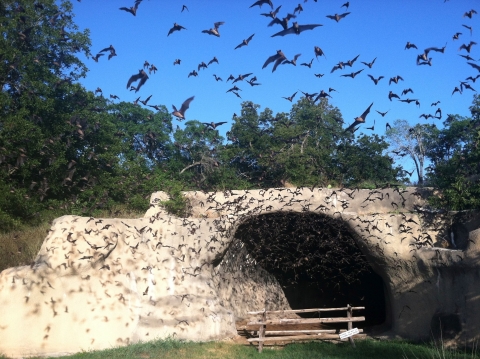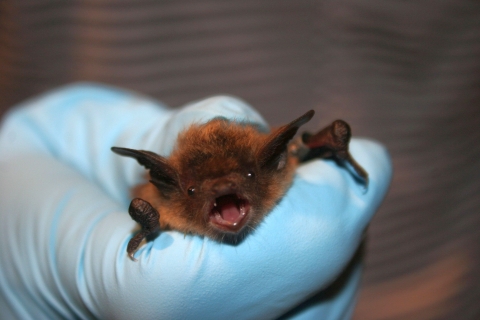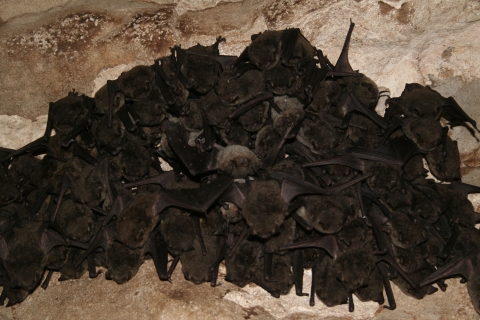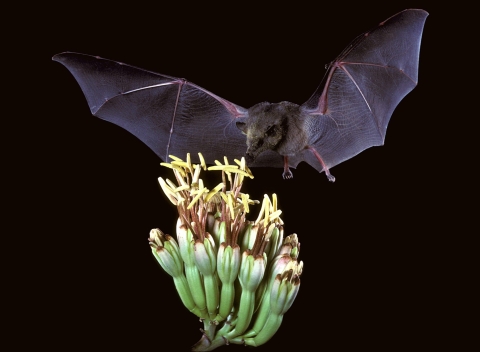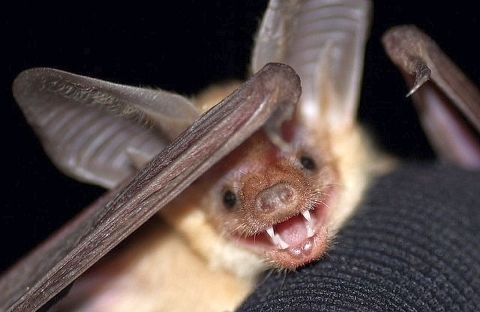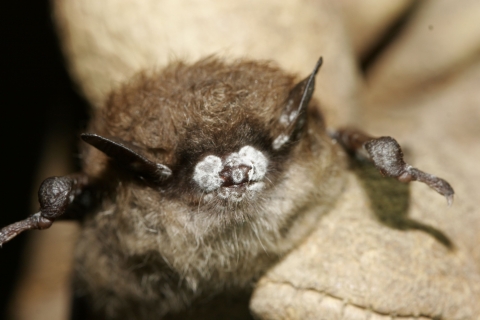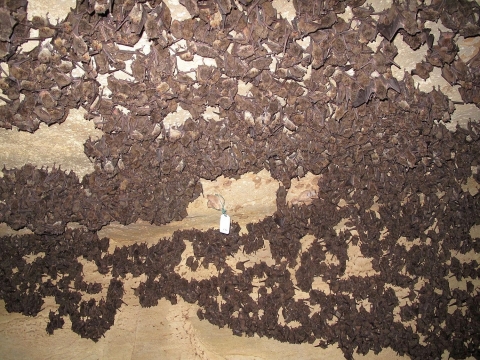We know. Bats can seem scary sometimes. But they are very cool animals. And they are important to all of us.
So, we asked our U.S. Fish and Wildlife Service colleague Ann Froschauer to answer a few questions about them.
Froschauer loves bats. She got interested in them in high school and has been studying them for many years. She has called them “the coolest mammals on Earth.”
Our First Question: Weren’t you afraid of bats when you first started studying them?
Froschauer's Answer: The first time I saw a bat up close I realized how tiny our North American bats are, and that they aren’t scary at all. Even though they look big with their wings stretched out, many of the bats that live here weigh only as much as a few coins, and have bodies about the size of your thumb. I think getting a chance to see a bat in real life helps a lot of people get over their fears.
Q. What do you find cool about bats, Ann?
A. One really cool thing about bats is that they are the only mammals that can fly. Bats' wings are really flexible and they can move them a lot of different ways, making them really good at flying. Bats have the same kinds of bones in their wings that humans have in their arms and hands.
Q. What is a typical day like for a bat from early spring to late fall?
A. From early spring to late fall, bats in North America are busy finding their summer roost, having and raising their pups, hunting for insects, finding a mate, and preparing for winter. Bats are nocturnal, which means they are active at night. During the day, bats spend most of their time sleeping in their roost, but once it starts getting dark, bats become active and fly off in search of a meal.
Q. How do bats see so well in the dark?
A. Bats actually have pretty good eyesight, but, like humans, that eyesight isn’t very useful when it’s dark outside and bats are active. So instead of using their eyes, many bats use “echolocation” – making really high-pitched sounds that bounce off of things, like objects they want to avoid or a juicy bug they want to catch for dinner. By listening to the sounds that bounce back, bats can determine where things are, how big they are, and if they are moving.
Check out this cool JumpStart! video, “Bat Echolocation Song.”
Q. The bat in the photo above looks frightened. When you examine a bat what do you do to make sure it’s not afraid of you?
A. People are a lot bigger than a bat, and I’m sure it is scary to be handled by a human. We try to help keep the bats as calm as we can by handling them as little as possible, being really gentle, and letting them go free as quickly as we can. If you find a bat, don’t handle it. Like all animals, bats may bite or scratch to protect themselves.
Q. Why do bats hibernate from late fall to early spring?
A. In places with cold winters where food is not available year-round, some bats will hibernate in caves, mines or other places like buildings or rock crevices. In order to survive months without food, bats slow down their bodily functions – like body temperature, heart rate and breathing – to conserve energy. Every few weeks, hibernating bats may warm up and move around for a short time before slowing down again.
Q.Why are bats good for people and for planet Earth?
A. Bats are amazing animals that are important to the health of our environment and people. Although we may not always see them, bats are hard at work all around the world each night – eating tons of insects, pollinating flowers and spreading seeds that grow new plants and trees. Believe it or not, many of the foods we like to eat depend on bats for pollination or pest control.
Without bats, there might not be any chocolate or coffee! Check out this fun “All About Bats!” video.
Q. How many different kinds of bats are there? Do you have a favorite one?
A. Worldwide, there are more than 1,400 species of bats. That’s almost 20 percent of all mammal species. Bats live almost everywhere on Earth except the most extreme desert and polar regions. There are about 47 species of bats in the United States. I like all kinds of bats, but one of my favorites is the pallid bat – they have beautiful white fur and huge ears, which they use to listen for the footsteps of prey like scorpions and centipedes.
Q. What is white-nose syndrome, and why is it bad for bats?
A. White-nose syndrome is a disease that is one of the biggest threats to bats in North America. It has killed millions of bats. The disease is named for the white fungus that appears on the nose, ears and wings of hibernating bats. Bats with white-nose syndrome wake more often during hibernation and use up the stored fat reserves they need to survive the winter.
Check out White-Nose Syndrome.org: A Coordinated Response to the Devastating Bat Disease.
Q. Why do bats hang upside down a lot, and do they ever get dizzy?
A. Hanging upside down has a few benefits for bats. Bats have special tendons in their feet that let them hang while being totally relaxed, so they aren’t using much energy. It allows them to take off quickly in flight also. Most bats are so small they probably don’t get dizzy like we might because gravity doesn’t make as much blood rush to their head. The same valves and muscles that keep blood from pooling to our feet are upside down in bats and keep blood from rushing to their heads.
Q. Some people might find the photo above scary. What is this bat doing?
A. I think this bat is echolocating. Remember, bats use sound to “see,” and they can actually focus the sound by opening their mouth wider. Bats also open their mouth wider when they are echolocating in a smaller space, and make their mouth narrower if they are trying to “see” what is in a bigger area.
Q. What are the U.S. Fish and Wildlife Service and other organizations and individuals doing to protect bats? And where can people go to learn more about bats?
A. The U.S. Fish and Wildlife Service works with a lot of organizations and people to protect bats and learn more about them. Staff members at many of our national wildlife refuges study bats and work to protect their habitat. That’s the case at Fern Cave National Wildlife Refuge in Alabama which is home to the largest wintering colony of gray bats. Other Fish and Wildlife Service biologists study white-nose syndrome and work with partners to try to help bats survive the disease.
Would you like to help out? Check out Bats Are One of the Most Important Misunderstood Animals.


